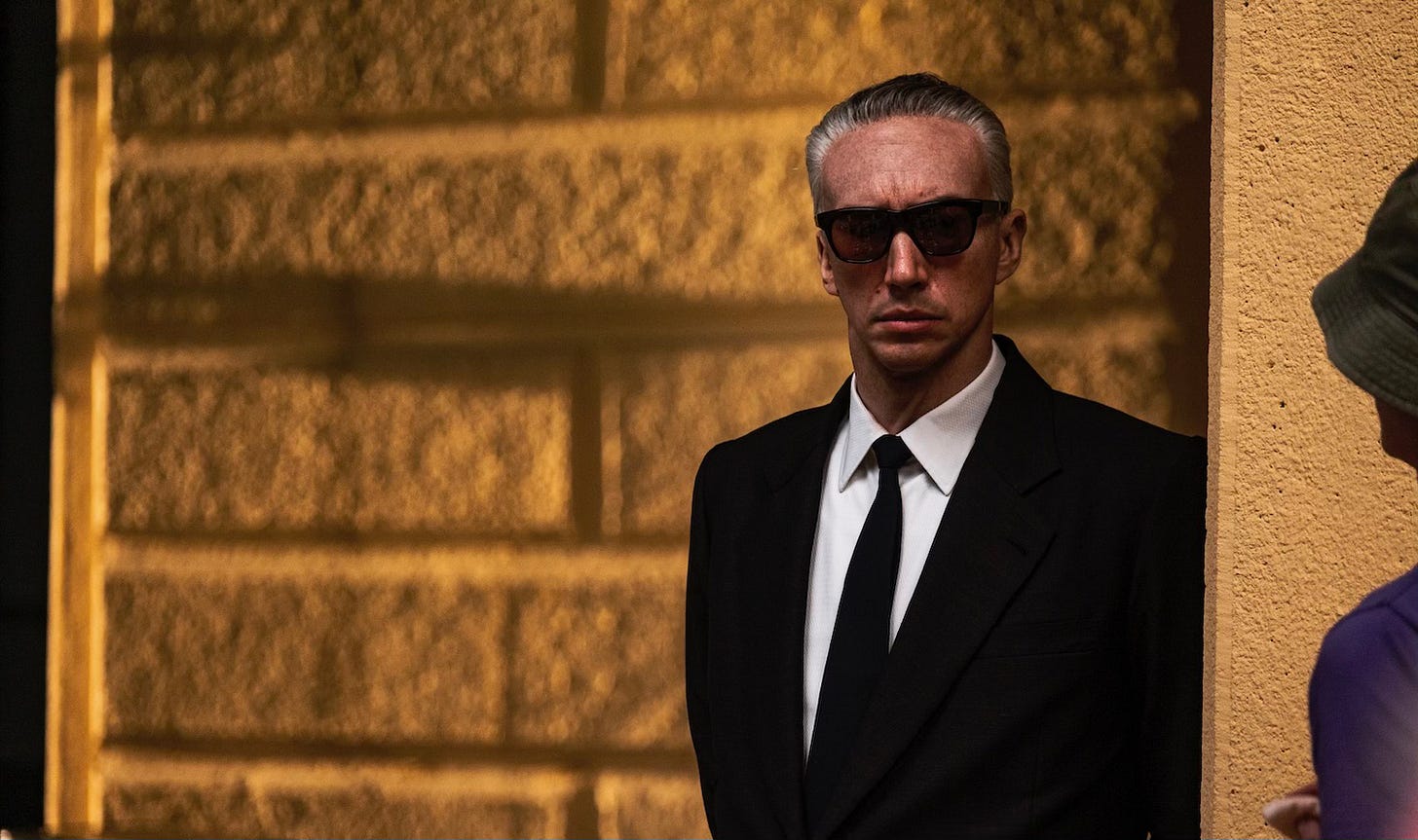Michael Mann has always told stories about men who are good at one thing, who have exacting standards and a drive to achieve. Mann’s own craft is a mirror for his subjects; he, too, is an exacting director with an eye for precision. Ferrari is a perfect fit for Mann’s sensibility.
This becomes apparent from the second sequence in the film, in which Enzo Ferrari (Adam Driver) speeds away from the house of his mistress Lina (Shailene Woodley) and their son Piero (Giuseppe Festinese). Enzo’s days as a racing driver are long behind him—he spends his time designing the cars now—but he still revels in driving fast, braking and shifting to keep the car moving along the most efficient line around a curve. The camerawork and editing relish that same precision, too; when Enzo brakes, engages the clutch, shifts gears, and accelerates, each action is granted its own swift shot, the speed of the cuts emphasizing how naturally Enzo drives, and how much joy he takes in moving the vehicle the way he wants it to go.
Enzo knows his racing comes at a cost. He refers to the sport as his “terrible joy”; he has lost good drivers, and some of his friends, to races that went poorly and to machinery that wouldn’t obey his designs, only the laws of physics. The family business of building luxury cars for kings exists only to propel that terrible joy to new speeds. But it is 1957 in Italy. World War II may be over, but the scars remain, and building luxury cars won’t keep the company afloat. Enzo’s marriage to Laura Ferrari (Penelope Cruz) is drowning as well. She’s his business partner; it’s her money that stands between Enzo’s racing and total oblivion. She’s grieving the death of their son Dino, and he’s unable to comfort her. Each wants something that the other cannot give.
Every scene between Enzo and Laura becomes a negotiation, almost on the level of a hostage standoff. In their scenes together, Driver and Cruz each act as though their scene partner’s choices are a gun pointed at them. The stakes of the film are more than just the results of Ferrari’s beloved races; they are existential, balancing the Ferraris’ livelihoods and the lives of their drivers. Enzo meets those stakes with impassive coldness whenever he negotiates with Laura, and Laura, for her part, meets his chilliness with smoldering embers. The love is gone, and yet these two cannot break away from each other. Mann’s direction rests in the tension of that space, the awful quiet before someone strikes, and then the fire after the strike, like fuel combusting in an engine.
Laura and Enzo are locked in a death spiral, unable to let go of their family business, their cars, and their complicated feelings toward each other. “Two objects cannot occupy the same space at the same time,” Enzo says when chastising his drivers for giving away the lead to a rival Maserati car in a race. To win the race, you have to accept that you’re driving a death machine and that you and your competitors may all die. You must have both the skill to drive the car and the will to match it. Enzo applies his racing philosophy everywhere else in his life. He’s exacting in his work and in his instructions to his drivers.
All of Michael Mann’s protagonists follow this pattern to one degree or another. They’re invariably men, and they each are invariably very good at one thing, whether it’s crime or detective work or hacking or driving a cab or reporting. That excellence comes at the cost of their personal lives. Mann has always been good at counting the cost of his protagonists’ successes against the lives of the women around them without reducing his female characters to plot points. He’s especially good at it in Ferrari, giving space and time for Laura’s justifiable rage to grow and abate in turn.
If the film falters at all, it’s in the depiction of Enzo’s relationship with Lina. Shailene Woodley is game, but her Italian accent is not up to the task. She asserts her own personhood to Enzo, but the film tells us more about her emotional and personal life than it shows us. The film slows down whenever Enzo goes to visit her house. It also slows in the aftermath of a disaster, late in the film, that proves what the audience has already been told: there is a fatal cost to racing, and if Enzo continues to pursue the thing he loves, more people will die because of the machinery he designed. The slowness is likely on purpose; it underlines the peace that Lina provides and the cognitive dissonance Enzo feels about balancing his work against the cold equations of physics. It just feels out of place with the propulsive nature of the rest of the story.
Early in the film, Enzo shows his son Piero a plan for an engine manifold, pointing out that well-designed things not only work better but also look more beautiful. Ferrari is beautiful, and efficient, and surprising. The racing sequences allow the camerawork to stretch out over the road as it follows the cars obeying the same ethos. We get the taste for speed and precision, and we understand why Enzo finds those things so seductive. The film roars like one of his engines. It’s a beautiful, terrible joy. —Sarah Welch-Larson
★★★☆
Ferrari is in wide release now.





